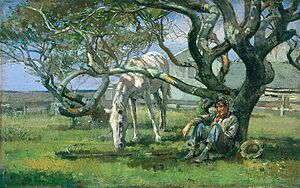Theodore Robinson facts for kids
Quick facts for kids
Theodore Robinson
|
|
|---|---|

Theodore Robinson, Self-portrait (c. 1884-1887), collection: Margaret and Raymond Horowitz
|
|
| Born | June 3, 1852 |
| Died | April 2, 1896 (aged 43) New York City, US
|
| Education | National Academy of Design, Art Students League of New York, Carolus-Duran, École des Beaux-Arts |
| Known for | Painting |
| Movement | American Impressionism |
Theodore Robinson (June 3, 1852 – April 2, 1896) was an American painter. He is famous for his beautiful Impressionist landscape paintings. He was one of the first American artists to start using the Impressionist style. This was in the late 1880s.
Robinson visited Giverny, France, and became good friends with the famous French painter Claude Monet. Many of Robinson's paintings are considered masterpieces of American Impressionism.
Becoming an Artist
Theodore Robinson was born in Irasburg, Vermont. His family later moved to Evansville, Wisconsin. He first studied art for a short time in Chicago.
In 1874, he moved to New York City. There, he took art classes at the National Academy of Design and the Art Students League.
Two years later, in 1876, he traveled to Paris, France. He studied with famous teachers like Carolus-Duran and Jean-Léon Gérôme. He showed his paintings for the first time at the Paris Salon in 1877.
After visiting Venice and Bologna, he came back to the United States in 1879. He opened an art studio in New York in 1881. He worked as a professional painter and art teacher. During this time, his paintings showed a realist style. They often showed people doing quiet everyday things.
Life in Giverny
In 1884, Robinson went back to France. He lived there for the next eight years. He often visited Giverny, a small village. Giverny was a popular place for Impressionist artists. This was because Claude Monet, a leading Impressionist, lived there.
It's not clear exactly when Robinson met Monet. But by 1888, they were close friends. Robinson even moved into a house next door to Monet. Robinson's art style changed to be more like traditional Impressionism. This was probably because of Monet's influence.
Many American artists gathered in Giverny. But no one was as close to Monet as Robinson. Monet gave Robinson advice about his paintings. Monet also asked Robinson for his thoughts on his own artworks.
Robinson learned a lot from Monet. He learned to paint nature truthfully and with his own unique vision. He also studied Monet's paintings in his studio. For example, Robinson's painting Capri (1890) was likely inspired by Monet's paintings of cliffs and rocks.
While in Giverny, Robinson created some of his best works. He painted the countryside in different weather. He often painted outside, a style called plein air. Sometimes, his paintings showed women relaxing. His painting Winter Landscape won an award in 1890 called the Webb Prize. Another famous painting from this time is La Débâcle (1892).
Coming Back to America
Robinson left France and Monet for the last time in 1892. He hoped to return someday. Back in America, Robinson started teaching art. He taught at the Brooklyn Art School. He also led summer classes in Napanoch, New York, near the Catskill Mountains. There, he painted many scenes of canals. He also taught at Evelyn College for Women in Princeton, New Jersey, and later in Philadelphia.
Robinson lived in New York City. He became part of a group of American artists who loved Impressionism. He was especially close to John Henry Twachtman and Julian Alden Weir. He also spent time at the Cos Cob Art Colony in Connecticut. There, he painted many boat scenes at the Riverside Yacht Club. These are now considered some of his best works.
Even though he was becoming a well-known American Impressionist, Robinson still needed to teach to earn money. He also sometimes worried about his own artwork. Theodore Robinson kept detailed diaries throughout his life. The last few years of these diaries are kept at the Frick Art Reference Library in New York.
Last Years
In his last year, Robinson was asked to write for a book called Modern French Masters. He wrote about the painter Jean-Baptiste-Camille Corot. Because he was friends with Claude Monet, he also wrote and drew pictures for the essay about Monet. This book was published in 1896.
In 1895, Robinson had a very productive time painting in Vermont. In February 1896, he wrote to Monet about going back to Giverny. But in April, he sadly died from a severe asthma attack in New York City. He was only 43 years old. He was buried in his hometown of Evansville, Wisconsin.
Today, you can see Robinson's paintings in many major museums. These include the Metropolitan Museum of Art in New York City, the Corcoran Gallery of Art in Washington, D.C., and the Art Institute of Chicago.
Artwork Gallery
-
Valley of the Seine from Giverny Heights, (1892), Corcoran Gallery of Art
-
House with Scaffolding, (1892), North Carolina Museum of Art
-
A French Hamlet , (1892) Brooklyn Museum
-
Theodore Robinson, Jamaica, Vermont, (1895)




















